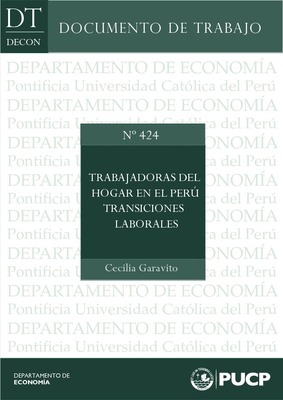| dc.description.abstract | El objetivo de este trabajo es analizar las transiciones desde el trabajo del hogar remunerado hacia otras ocupaciones, el desempleo y la inactividad, así como los determinantes de estas transiciones. Para ello empleamos los datos panel de la ENAHO para los periodos 1998 – 2002, 2002 – 2006 y 2007 – 2011. Luego de un análisis detallado de las transiciones parciales y totales de cada panel, encontramos que alrededor de un tercio de las trabajadoras del hogar se quedan en la misma ocupación y que un porcentaje similar pasa a al trabajo independiente o a ocupaciones asalariadas de baja productividad. Luego de estimar las transiciones desde el trabajo del hogar remunerado hacia otras ocupaciones y hacia el desempleo o la inactividad, encontramos que un mayor nivel de educación está siempre asociado a una salida hacia otra ocupación. Asimismo, un mayor salario potencial tiene un efecto positivo en la salida hacia otras ocupaciones solamente en el panel 2002 – 2006, el único en el cual no hay crisis económicas. Por otro lado, la edad siempre disminuye la movilidad laboral. Finalmente, encontramos que en los paneles 1998 – 2002 y 2007 – 2001, en los cuales hay crisis económicas, aumentan tanto las salidas hacia otras ocupaciones —posiblemente relacionadas a caídas en la demanda—, así como las salidas hacia la inactividad.
The objective of this work is to analyze transitions from paid housework toward other occupations, unemployment and inactivity, and the determinants of these transitions. We use the panel data from the ENAHO for the periods 1998 – 2002, 2002 – 2006, and 2007 – 2011. After a detailed descriptive analysis of partial and complete panels, we find that around one third of the paid house-workers stay in this occupation while a similar percentage moves to independent work or low productivity salaried work. After estimating the transitions from paid housework to other occupations, and to unemployment or inactivity, we find that a higher level of education is always related to a transition toward another occupation. Additionally, a higher potential salary has a positive effect on the transition toward another occupation only in the panel 2002 – 2006 where there is no economic crisis. On the other side, age always means less mobility. Finally, we find that in the panels for 1998 – 2007 and 2007 – 2011, in which there are economic crises, there are more transitions toward another occupations —probably related to falls in demand—, and out of the labor force. | en_US |


